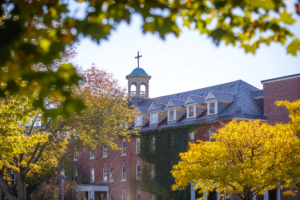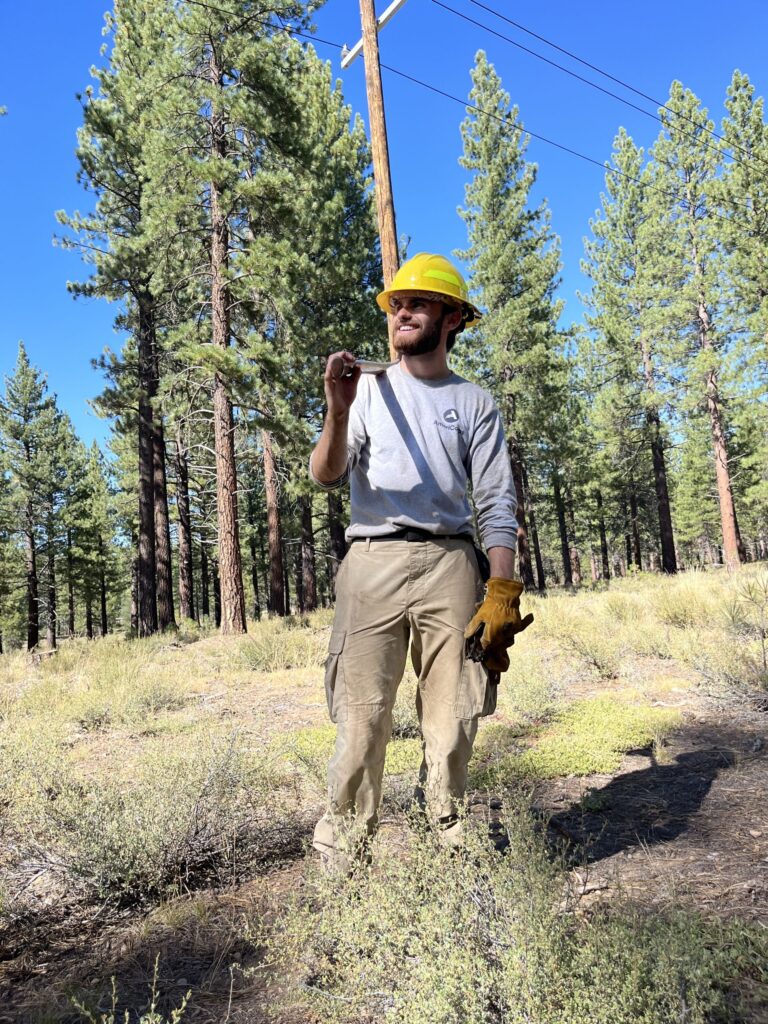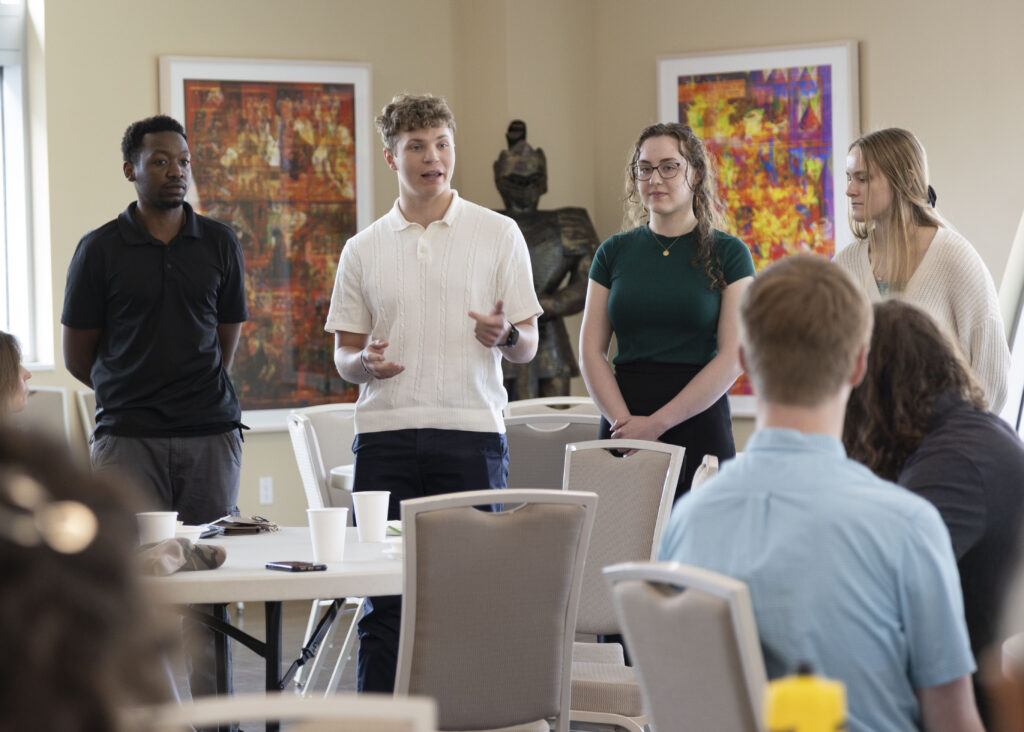Founders Hall will be coming down, likely in 2019
Founders Hall, the most iconic Saint Michael’s building with sections dating to the College’s very beginnings, regrettably has outlived its useful life and will be taken down before the end of 2019.
College leaders officially made their decision at the June meeting of the Trustees in a vote on the Operations and Audit Committee’s recommendation, based on years of studies and discussions that pointed firmly to the practical and financial inevitability of taking down the worn-out, weary and quirky brick-over-wood campus landmark.
Just bringing it up to longer-term fire code and undertaking a 20-year-overdue roof replacement to keep its present limited uses operative would cost prohibitive millions of dollars, said President Jack Neuhauser, who had wanted a decision formalized on the matter before his tenure as president ends later in June. “The general sense among the Trustees is that it’s very regrettable that we can’t save the building, but you really can’t sink more money into it at a time when we don’t have a large amount of construction funds,” said Neuhauser.
Already, the top three formerly residential floors of Founders have been shut down for four years, with only the ground floor utilized by administrative offices: the president, dean, vice president for academic affairs, registrar, and some others. One likely option at this point would be to move most of those offices to the first floor of Joyce Hall, which could be gutted and renovated to become office suites beginning in possibly February of 2019, said Jim Farrington, director of facilities and the College architect.
Farrington explained particulars behind the decision: “Founders is built poorly – bricks of the façade have rusting old nails holding them to the old wood facade, the insulation is poor, the windows are terrible, and it would cost $2-million-plus just to keep it in ‘as-is’ condition,” he said. But even beyond the prohibitive renovation cost, he said, the building’s unusual and dated layout, low ceiling heights, inability to accommodate desirable HVAC infrastructure, and other drawbacks “would not provide us with a building we would want, even with renovations.” It is currently safe with a satisfactory fire-alarm system installed a few years ago, but any more occupants would require improvements.
Neuhauser said that his personal hope is that someday, if not in the near future, a building of similar look and character might be built if only funding would become available — but such a building might be perhaps just three stories and, ideally from his perspective, include space for students or Edmundites to live above office spaces, as before.
For now, Farrington said, the open space created once Founders came down likely will become an attractive landscaped area with vegetation. Observed Farrington, “Cheray Science Hall is a pretty handsome building, and with some nice landscaping between it and the road once Founders comes down, it would create nice frontage on Route 15.” He further noted how ugly the present stair-tower at the south end of Founders already is for drivers going by the campus. He added that state historical preservation officials have studied the building in recent years and agreed with the determination that Founders is not restorable or salvageable.
Farrington said the proposed Joyce project would be “what we call an enabling project – we’d have to have that or something else done to move people out of Founders, so we’re working on pricing and finalizing design on that possibility.” If all goes as he anticipates, “the tentative schedule would begin renovations there on Feb. 1, though design and permitting is yet to happen,” he said. In that scenario, a target might be completion in May or June of 2019, “which would enable moving in over summer and starting the process of taking down Founders in Fall of 2019.”
The Founders demolition would not require equipment any larger than a good-sized backhoe once any slower and more painstaking abatement or reclamation of materials is complete, he continued. Once emptied and with the early steps complete, the area would be fenced in for the demolition, and what’s left after the knock-down would be taken away by trucks. “It won’t take much more than a week for that part,” Farrington said.
Neuhauser gave his best guess on near and longer-term expectations: “Were going to use it as a quiet space for now, and if ever we have the resources or a capital campaign in the near-term, we might not be able to repair it but we can put something that is reminiscent, and maybe put the iconic bell-tower or something reminiscent of it back,” he said. “If you had the money you’d eventually like to do something similar in pretty much the same place — ideally a reminiscent building but constructed under today’s green standards.”
The president likes several aspects of the proposal for relocation to Joyce of the College’s administrative offices. (Already the College mailroom and printing services are in the Joyce basement, with first- and second-year students occupying the first through fourth floors.) Such a renovation would take about 100 student beds offline – but it had been previously determined that about 100 student beds would not be needed because recent new residences and intentionally slightly smaller class sizes of recent years mean the change would not cause difficulties as far as adequate housing.
“I think it would consolidate Student Affairs and Academic Affairs and we might have a quadrangle between Alliot, Joyce and Dion with all the student services,” Neuhauser said, adding that any specific design on the proposed project is still to come, however.
As for the present popular use of the upper Founders floors for relatively low-cost student storage over the past few years, the president said: “I’m hoping we can find some other space for that storage, and I think we can.” Also, “it’s a wonderful business opportunity for some students and common practice at other campuses where students start little companies and provide storage for other students.”
Neuhauser said when he talked to engineers and architects, they told him that “to construct a new structure reminiscent of Founders would take $12-$15 million or so, and we don’t have that kind of resources — so we have to take it down one way or another; and for a fraction of that, maybe $1 million, we could build all the office space you’d ever need.”
A central consideration in the entire coming process is to proceed with due respect for the history and memories associated with Founders Hall, Neuhauser said.







